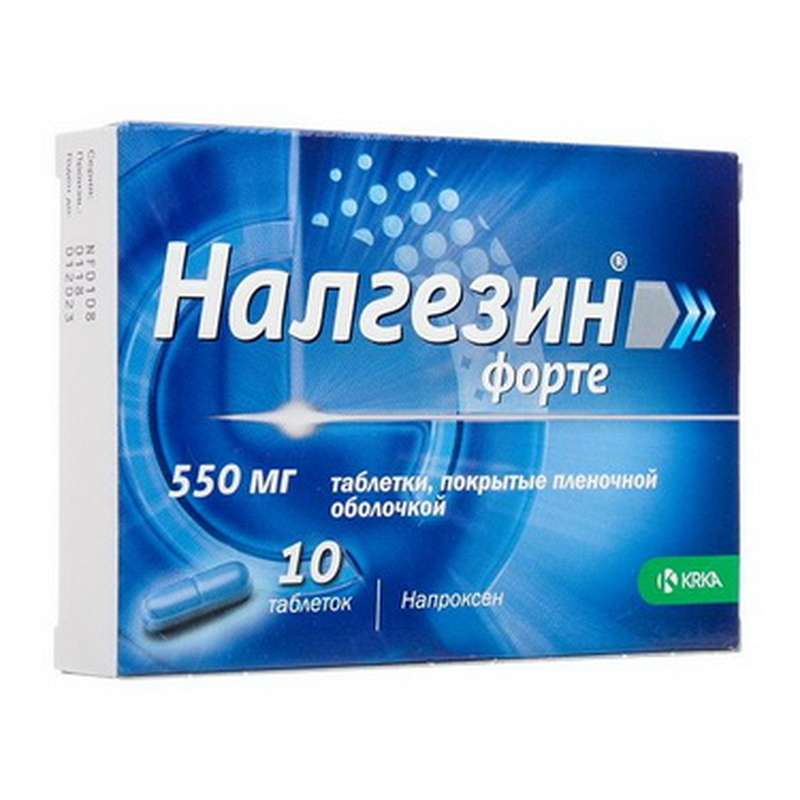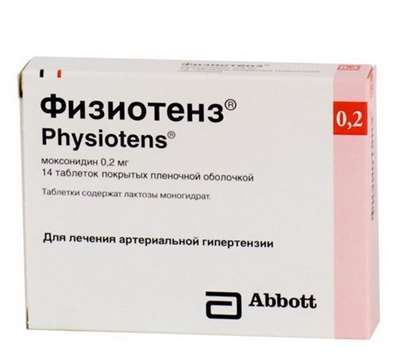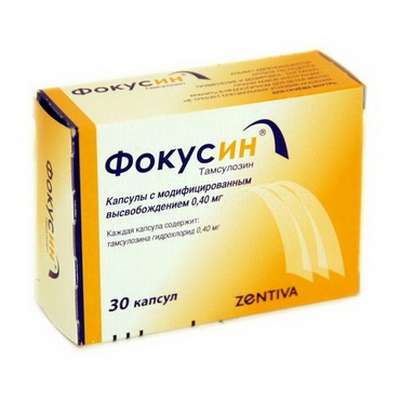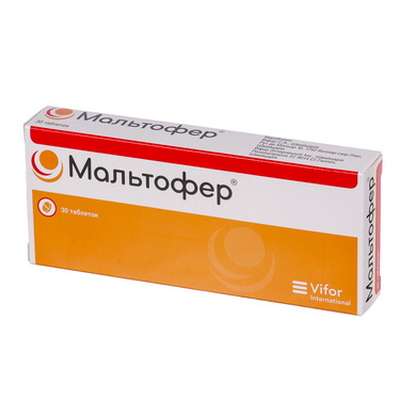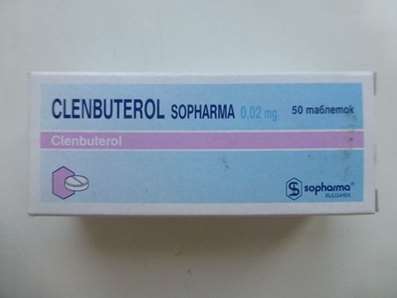Nalgesin forte - It has anti-inflammatory, analgesic and antipyretic properties. The main mechanism of action is the inhibition of cyclooxygenase, an enzyme that is involved in the formation of prostaglandins. As a result, the level of prostaglandin in various body fluids and tissues is reduced.
Nalgezin forte, is a drug naproxen, has analgesic, antipyretic and anti-inflammatory effect. The mechanism of action is associated with a non-selective inhibition of cyclooxygenase 1 and 2 (COX-1, COX-2) activity. The film-coated tablets, Nalgezin forte, dissolve well, are rapidly absorbed from the gastrointestinal tract and provide a rapid onset of the analgesic effect.
Pharmacokinetics
Absorption from the gastrointestinal tract - fast and complete, bioavailability - 95% (eating practically does not affect either the completeness or the rate of absorption). The time to reach the maximum concentration is 1-2 hours, the connection with plasma proteins> 99%, the half-life is 12-15 hours. Metabolism is in the liver to dimethylnaproxen with the participation of the CYP2C9 enzyme system. Clearance - 0.13 ml / min / kg. It is excreted 98% by the kidneys, 10% of them are excreted unchanged; with bile - 0.5-2.5%. The equilibrium concentration is determined by taking 4-5 doses of the drug (2-3 days). With renal failure, metabolites can be accumulated.
Indications:
Diseases of the musculoskeletal system (rheumatoid arthritis, psoriatic, juvenile chronic arthritis, ankylosing spondylitis (Bekhterev's disease), gouty arthritis, rheumatic soft tissue damage, osteoarthritis of peripheral joints and spine, including radicular syndrome, tendovaginitis, bursitis),
Pain syndrome of mild or moderate severity: neuralgia, ossalgia, myalgia, lumboschialgia, posttraumatic pain syndrome (sprains and bruises), accompanied by inflammation, postoperative pain (in traumatology, orthopedics, gynecology, maxillofacial surgery), headache, migraine, algodismenorea, adnexitis, toothache.
In the complex therapy of infectious and inflammatory diseases of the ear, throat, nose with severe pain syndrome (pharyngitis, tonsillitis, otitis).
Feverish syndrome with "colds" and infectious diseases. Nalgezin forte is used for symptomatic therapy (to reduce pain, inflammation and reduce elevated body temperature) and does not affect the progression of the underlying disease.
Contraindications:
Hypersensitivity to naproxen or naproxen sodium; with anamnestic data on an attack of bronchial obstruction, rhinitis, urticaria after taking acetylsalicylic acid or other NSAIDs (complete or incomplete acetylsalicylic acid intolerance syndrome - rhinosinusitis, urticaria, polyps of the nasal mucosa, asthma);
Period after aortocoronary bypass surgery;
Erosive and ulcerative changes in the gastric mucosa or duodenum, active gastrointestinal bleeding;
Inflammatory bowel disease, in the phase of exacerbation (Nonspecific ulcerative colitis (NJC), Crohn's disease);
Cerebrovascular bleeding or other bleeding and hemostasis disorders;
Severe hepatic impairment or active liver disease;
Severe renal insufficiency (creatinine clearance less than 20 ml / min), including confirmed hyperkalemia, progressive kidney disease;
Oppression of bone marrow hematopoiesis;
Pregnancy, the period of breastfeeding;
one Nalgezin forte tablet contains 550 mg of naproxen, so the drug is not recommended for children and adolescents under 15 years of age.
With caution: coronary heart disease, cerebrovascular disease, congestive heart failure, dyslipidemia / hyperlipidemia, diabetes mellitus, peripheral arterial disease, smoking, creatinine clearance less than 60 ml / min; anamnestic data on the development of gastric ulcerative lesions, the presence of Helicobacter pylori infection, old age, prolonged use of NSAIDs, frequent alcohol consumption, severe physical illness, concomitant therapy with anticoagulants (eg, warfarin), antiplatelet agents (eg acetylsalicylic acid, clopidogrel), oral glucocorticoids (eg, prednisolone), selective serotonin reuptake inhibitors (eg, citalopram, fluoxetine, paroxetine, sertraline). To reduce the risk of developing adverse events from the gastrointestinal tract, the minimum effective dose should be used as little as possible. Children younger than 16 years of age, the drug is prescribed only on the advice of a doctor.
Suggested Use:
Inside. Follow the doctor's instructions strictly. You should not stop treatment or change your dosage without first consulting a doctor. Ask the doctor the duration of the drug.
Recommended therapy scheme:
The usual daily dose used to relieve pain is 1-2 tablets (550 - 1100 mg).
With very severe pain and no history of gastrointestinal diseases, a doctor can increase the daily dose to 3 tablets (1650 mg), but not more than 2 weeks. When using the drug as an antipyretic agent, the initial dose is 1 tablet (550 mg), then 1A tablet (275 mg) is taken every 6-8 hours. To prevent migraine attacks, 1 tablet (550 mg) is recommended twice a day. However, treatment should be discontinued if the frequency, intensity and duration of migraine attacks do not decrease within 4-6 weeks. At the first signs of a migraine attack, you should take \ Ug tablets (825 mg), and if necessary 1/2 - 1 tablet (275 - 550 mg) after 30 minutes.
For the relief of menstrual pains and spasms, pain after injection of the IUS (intrauterine spirals) and other gynecological pains (adnexitis, childbirth as an analgesic and tocolytic agent), it is recommended that the drug be administered at an initial dose of 1 tablet (550 mg), then 1/2 tablets (275 mg) every 6-8 hours.
With an acute gout attack, the initial dose is 11/2 tablets (825 mg), then 1 tablet (550 mg) after 8 hours, and then 1/2 tablet (275 mg) every 8 hours until the seizure stops.
In rheumatoid diseases (rheumatoid arthritis, osteoarthritis and ankylosing spondylitis), the usual initial dose of the drug is from 1-2 tablets (550-1100 mg), twice daily in the morning and in the evening. The initial daily dose of 1/2 (825 mg) - 3 tablets (1650 mg) is recommended for patients with severe night pain and / or severe morning stiffness, patients transferred to treatment with naproxen sodium with high doses of other non-steroidal anti-inflammatory drugs, and patients , in which pain is a leading symptom. Usually the daily dose is 1 tablet (550 mg) - 2 tablets (1100 mg), administered in two divided doses.
Morning and evening doses may not be the same. With the consent of the attending physician, you can change them depending on the prevalence of symptoms, i.e. night pain and / or morning stiffness. If you get the impression that the effect of the drug is very strong or weak, inform your doctor or pharmacist.
Side effects:
Side effects are most frequent when using high doses of Nalgezin forte:
- from the digestive system: constipation, abdominal pain, indigestion, nausea, diarrhea, ulcerative stomatitis, erosive and ulcerative lesions and bleeding of the gastrointestinal tract, increased activity of "liver" enzymes, impaired liver function, jaundice, bloody vomiting, melena;
- Central nervous system: hearing loss, dizziness, headache, drowsiness, depression, sleep disorders, inability to concentrate, insomnia, malaise, myalgia and muscle weakness, slowing reaction rate, aseptic meningitis, cognitive dysfunction;
- from the skin: itching, ecchymosis, excessive sweating, purpura, alopecia, photodermatosis;
- On the part of the sense organs; tinnitus, visual impairment, hearing impairment;
- From the side of the cardiovascular system: puffiness, shortness of breath, palpitations, congestive heart failure, vasculitis;
- On the part of the genitourinary system: glomerulonephritis, hematuria, interstitial nephritis, nephrotic syndrome, renal failure, renal papillary necrosis, menstrual irregularities;
- from the hemopoietic organs: eosinophilia, granulocytopenia, leukopenia, thrombocytopenia, aplastic anemia;
- from the respiratory system: eosinophilic pneumonitis;
- allergic reactions; skin rashes, hives, angioedema, epidermal necrosis, erythema multiforme, Stephen-Johnson syndrome;
- Others: thirst, hyperthermia, hyperglycemia, hypoglycemia, increases bleeding time, hemolytic anemia.
If you notice such a phenomenon, stop taking the medication and, if possible, consult your doctor.
Packaging:
- Comes in original packaging. Item is brand new and unopened.
Storage:
- Keep away from direct sunlight.
- Keep locked and away from children.
- Store in dry place at room temperature.
- Do not exceed storage temperature higher than 25 C
Important notice- the outer box design may vary before prior notice!

 Cart
Cart
